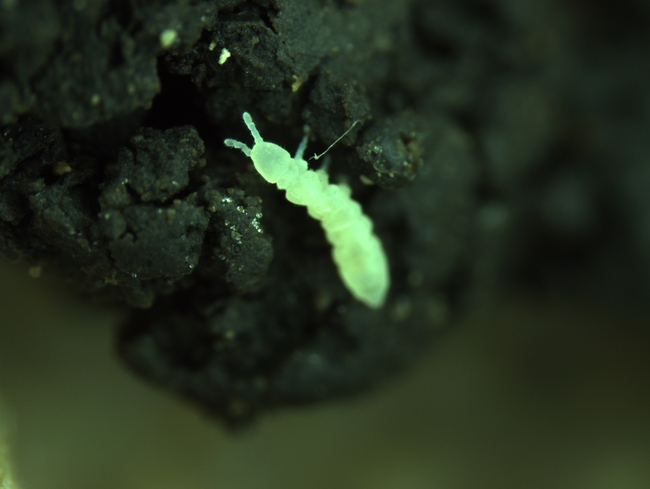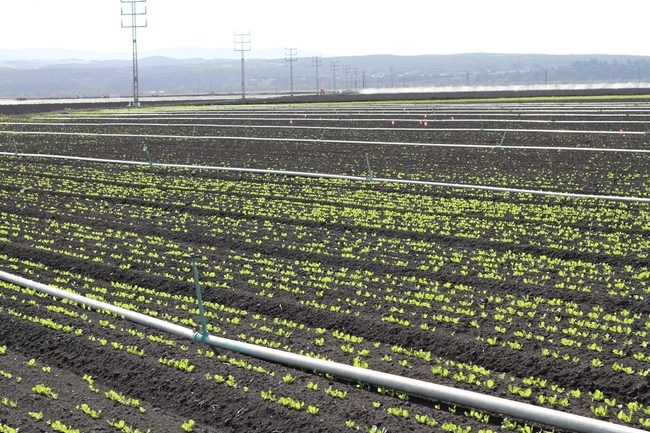Springtail (Protaphorura fimata) (Figure 1) is a serious pest of lettuce in the northern part of Salinas Valley of California. The direct seeded young lettuce seedlings in fields with high densities of springtail show retarded or stunted growth and do not emerge in a synchronous pattern (Figure 2). Springtails are reported to feed on soil fungi, decaying plant materials and live roots.
Springtails attack the germinating seeds of the lettuce, but it is not certain if irregular or inconsistent plant stand is due to the persistent feeding by springtail on both germinating and developing seedling stages of lettuce. Springtail continue to occur in the soil beyond 30 days after planting. Knowing the most vulnerable stage(s) of lettuce to springtail feeding will help in determining the best timing for control measure intervention to achieve a uniform lettuce stand.
Lettuce fields are heavily irrigated at least once before and up to three weeks after planting the seeds for uniform seed germination and seedling establishment. However, the behavioral response of springtail to feeding injury on lettuce under high soil moisture condition has not yet been studied in the central coast of California.
Similarly, the temperature has a profound impact on lettuce plant development as well as the growth and activities of springtail. Springtail has been found causing crop losses during February to May in the Salinas Valley and beyond June, springtail related problems are not widely reported. Perhaps slower lettuce seed germination and subsequent development during cooler seasons (January to May) is the pre-disposing factor as seedlings are exposed to springtails for an extended time frame than during the rest of the year. The relationship between temperature and springtail feeding of germinating lettuce seeds has not been investigated.
A study was conducted to determine the effect of germinating stages of lettuce seeds (up to 7 days after planting), soil temperature and moisture to springtail feeding injury.
Germinating seeds or one day old lettuce seedlings were the most vulnerable stage to springtail feeding, resulting in reduction in seedling growth. Thus, it appears that once the roots are established in the soil, lettuce is less susceptible to springtail feeding injury. Because the germinating phase of the plants is more likely to be injured, springtail monitoring activity should start prior to planting the seeds to determine the presence of springtail in the soil. Previous studies showed that, beet or potato slice baits attract springtail if placed in the top layer of the soil; thus, these baits could be used for monitoring springtail activity in the soil. If the soil is not moist, the baits may not capture springtail and springtail activity may go undetected.
When the experiments were conducted with germination phase in the temperatures as low as 41°F, springtail feeding was still evident. This suggests that although the seed germination and seedling development is progressing slowly in the cooler temperatures, springtail can be still active in feeding if there is sufficient moisture in the soil. Also, this suggests that lettuce seedlings might require prolonged protection from springtail with additional insecticide sprays until the seedlings are established in the cooler temperatures especially in spring and early summer (January to May). In the later part of summer and fall, the temperatures are higher than 60°F even at nights, which allows the seeds to germinate and develop quickly and not providing springtail to persistently feed and cause economic damage. In these circumstances, an at-plant application of insecticide is likely to provide adequate springtail control and multiple applications may not be required.
High moisture content in the soil will favor springtail feeding on the germinating lettuce seeds. In the Salinas Valley, before the lettuce seeds are planted, fields are pre-irrigated to aid land preparation and bed shaping. It has been observed that the springtail density increased from the sub-surface of soil when the field was recently irrigated or after a rain event. This cultural practice which maintains high moisture levels for seed germination on the sub-surface profiles of the soil might be favoring the faster buildup of springtail populations. Springtail captures in bait traps were greater immediately after irrigation.
Clearly, this study demonstrates that early lettuce seed development stages are the most vulnerable to springtail feeding injury. Moisture has a profound effect on springtail feeding on germinating lettuce seeds. This study also suggests that springtail can attack the germinating lettuce seeds at all growing temperatures in the Salinas Valley, although the seed germination and subsequent seedling development at cooler temperatures would increase the vulnerability of lettuce seeds to springtail feeding. This information provides insights not only on the timing of protection but the extent of protection under various temperature ranges also in managing springtail in the Salinas Valley. Plants growing the cooler temperature need prolonged protection for springtail if adequate moisture is present in the top soil of the bed. In the warmer temperatures, seed development would occur rather quickly which suggests that prolonged protection against springtail is not necessary. These results warrant the need for more field studies on protecting lettuce seeds from springtail in the cooler temperatures especially during spring and early summer lettuce plantings in the Salinas Valley.
If interested in the details of the study, please read the published article:
http://cemonterey.ucanr.edu/files/253284.pdf

